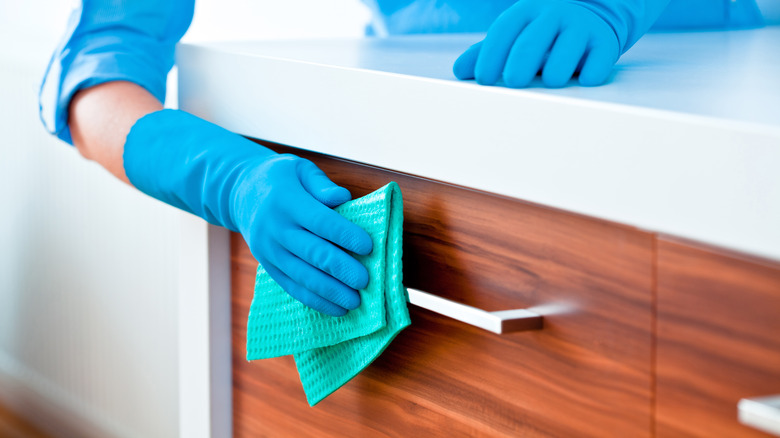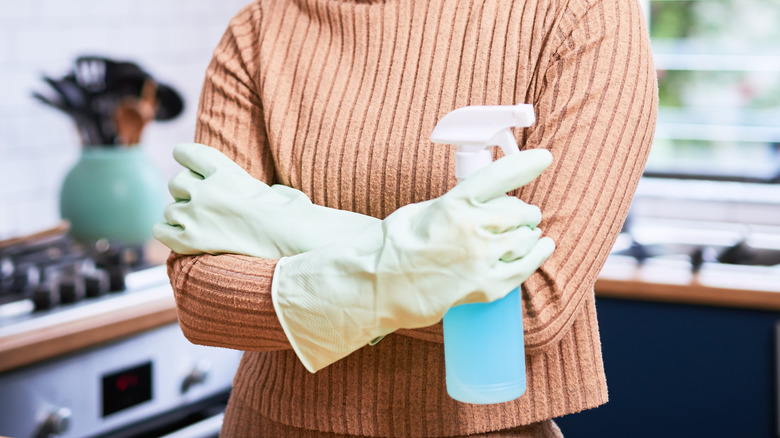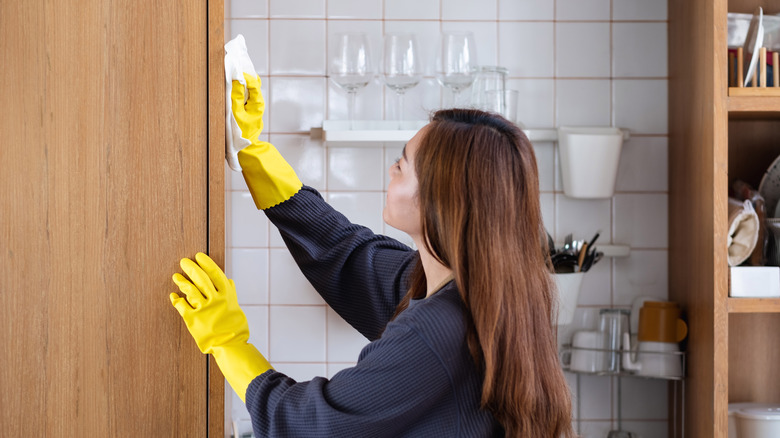Think Twice Before Using This Popular Cleaner To De-Grime Your Cabinets
Our kitchen cabinets take quite a beating. Grease from the stove embeds itself into shaker grooves or decorative accents, sticky fingers add gunk to handles, and smudges adorn cabinet doors. Because of that, wiping down their faces is probably part of your monthly cleaning routine. However, you might want to think twice before reaching for a bottle of Windex to clean your kitchen cabinets. While the blue bottle might be a go-to, all-purpose cleaner for many of your household chores, you want to avoid using it on wood. That's because the ammonia in the formula can damage the finish, dulling or discoloring the cabinet faces.
While Windex is one of the most obvious ammonia cleaners to avoid, you want to skip using any product with ammonia in its ingredient list when cleaning wooden surfaces. This can include any glass cleaners, disinfectant sprays, bathroom cleaners, and even some wood cleaners such as Pledge. Because of that, make sure to take a peek at the label before spraying it onto your pieces. Here is why.
Why you can't use ammonia on wooden cabinets
You might be tempted to reach for Windex when tackling kitchen messes because ammonia is very good at breaking down grease and oil. It acts a lot like soap in that its molecular structure allows it to pick up grease, break it down into smaller pieces, and allow water to wipe it away easily. While convenient, it has its limits. Since it's such a corrosive substance, it can eat away at the protective finish on wooden cabinets. If they're coated in a water-based finish, it can also cause that layer to turn white and cloudy, creating noticeable discoloration. If it gets to the wood underneath, it can begin to slowly dissolve it.
Since ammonia can cause more damage than good, it's best to avoid it. While some blogs or cleaning websites might recommend using it when diluted with water — especially if you're trying to remove wax buildup — you still run the risk of stripping the finish and discoloring the wood. It's best to completely avoid it to stay on the safe side.
How to clean grease-splattered wood instead
Now that you know what not to do, you might be wondering what you can do. After all, caked-on grease isn't easy to remove, and not many people want to be stuck scrubbing their wooden cabinets for hours in an effort to remove those stubborn splotches. The best thing you can do is use a grease-fighting dish soap such as Dawn. Since it's specially formulated to tackle tough oil build-up, it will easily cut through grease and grime on your cabinets. Simply fill a bucket with warm water, add a few drops of dish soap, and wipe down your cabinets with a microfiber cloth. (You want to specifically use warm water since it will help loosen the oil and grime.) Afterward, wipe it dry with another cloth, taking special care not to leave behind water or moisture as that can damage cabinets as well.
You want to avoid using anything like Murphy Oil Soap, since it will coat your cabinets in a thick film that's very difficult to rinse away. "That works as a magnet for dirt," Christopher Brazie, technical services specialist in Sherwin-Williams Co.'s wood coatings department, told The Washington Post. This can cause havoc in a place like a kitchen, where it's super important to keep dust and debris to a minimum. Instead, you don't need anything fancier than good, old-fashioned soap and water.


